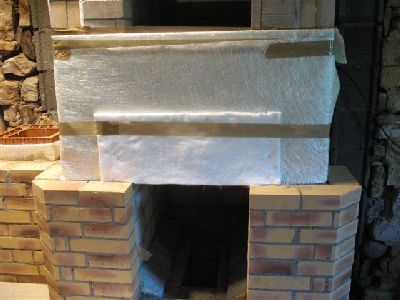Expansion Gasket Between Core And Facing
Rock Wool
The first two or three heaters I built using sheets of 1/4 inch thick mineral wool as an expansion gasket. I did this as I was shown to do it that way.
The wool sheets were affixed to the core with refractory mortar.
Cut from a block with a band saw, the sheets tended to be of irregular thickness, and were very fragile. It is difficult to work with, difficult to acquire, relatively expensive, and a health hazard for the installer.
Non combustible, it, to an extent, forms a smoke gasket between the core and facing.
Cardboard
After being introduced to cardboard I began to buy sheets of new cardboard from a local factory. I found a thickness and format which corresponded to what I perceived as necessary. Too thin and and it may not offer enough space for expansion, too thick and it will reduce transfer efficiency. Also the cardboard has to be strong enough to hold up to the brick being layed against it and backfilled, without collapsing.
The cardboard is cut to size and taped to the core with packing tape.
The cheapest option. Though combustible. Probably giving twice the expansion necessary and so reducing transfer efficiency.
Finding large undamaged sheets of the correct thickness is not always easy. Using cardboard boxes is tedious, demands much more tape, and folds and creases can potentially allow mechanical bridging.
Easy to work with, I used cardboard for many years before changing to fiberglass mat.
Though combustible, cardboard once installed will not actually burn as it is physically trapped between the core and backfill, having no potential supply of oxygen. In the cases where heaters have been demolished or repaired, the cardboard has been found to be relatively intact, burning, or rather blackening, just around the fire box and oven loading openings.
Though in my opinion not a great fire hazard, it would be difficult to explain this to a building inspector or fire officer. Today when ever possible I use fibreglass mat, as where fire is concerned, there are no slight risks.
Fiberglass

500g fiberglass mat can be bought on a 4 foot wide roll. It is cut to size and taped to the heater with packing tape.
Incombustible and variable in thickness, it is the most efficient way of maintaining physical separation between the core and facing. On the front and rear faces of the core, where there is considerable expansion, three or four sheets can be applied. On the sides where there is no lateral expansion, only one sheet is used, as a slip joint. This is a big advantage over cardboard. Also the fiberglass itself is relatively dense. Being more flexible than cardboard it grips any unconformities in the face of the core reducing the likelyhood of slight air pockets between the gasket and the core after backfilling.
Fiberglass mat can be used to gasket refractory brick benches or flue tiles that would be back filled. Much more precise than cardboard.
I discovered the wonders of Glass Mat when facing a’ Heat Kit’ refractory core, which was provided with a gasket already installed. I have worked with it whenever possible since.
Expensive and difficult to work with, extremely fragile, and often difficult to acquire.
Incombustible and Professional.
All the above gasketing options are for a cold climate situation where rapid transfer from the core to the facing is required.
See MHA discussion on this subject
Marcus Flynn
2008
